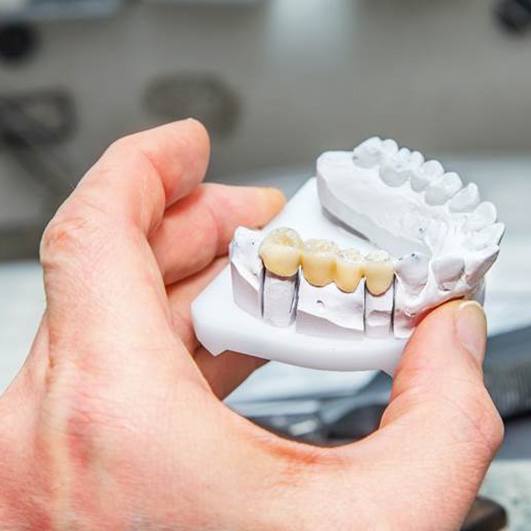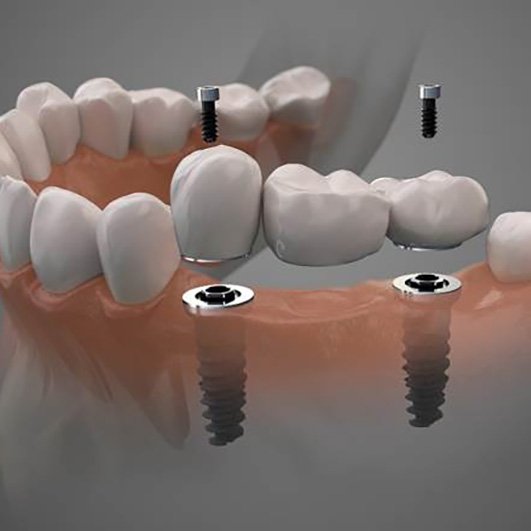Tooth loss is a common issue that people face all throughout the country. In fact, approximately 178 million Americans are missing at least one tooth. Fortunately, just because you’re missing a tooth doesn’t mean that you need to go the rest of your life with an unsightly gap in your smile. At NU Dental of Barnegat, Dr. Admasu Gizachew offers customized dental bridges to restore the appearance and function of your smile. To learn more about dental bridges in Barnegat, contact our office!
What is a Dental Bridge?

A dental bridge is a type of restoration that can be used to replace one or several consecutive missing teeth. This can be anywhere from a single tooth to four teeth in a row. The bridge is comprised of two crowns and a number of replacement teeth, also known as “pontics.” The crowns are anchored on the adjacent teeth or implants (depending on the type of bridge that you need). Bridges can be crafted out of numerous different materials, but porcelain is usually the best choice for a strong, natural looking restoration.
Types of Dental Bridges

If it’s determined that you make a good candidate for a dental bridge, there are two different types that you could end up with. Here is what each one entails:
Traditional Bridge
If you still have healthy teeth on each side of the gap that needs to be filled in, a traditional bridge is ideal. The teeth that support dental crowns are known as “abutment teeth,” and they need to be altered slightly in order for the bridge to fit properly. This type of restoration can be placed in just a few visits and is typically less pricy than their implant alternative.
Implant Bridge
Dental implant bridges can be used when there are three or more missing teeth in a row. Instead of being placed over abutment teeth, the crowns are placed on the titanium implants that merge with the jaw and act as artificial tooth roots. Implant bridges last longer than traditional bridges on average and help to prevent jawbone deterioration in the future as a result of tooth loss.
The Benefits of Dental Bridges

A dental bridge is a relatively simple, yet cost-effective option for replacing missing teeth. In addition to providing strength and stability for chewing and speaking, they help to maintain the shape of your face. They also keep your natural teeth from shifting out of place and causing misalignment issues in the future.
Dental Bridges FAQs
Can You Take a Dental Bridge Out?
No. Once Dr. G has placed your bridge, you shouldn’t be able to remove it on your own. Only a licensed
dentist in Barnegat can take it out. While you may have heard partial dentures be referred to as
“removeable bridges,” that’s not entirely accurate, as partials are their own separate type of
dental restoration. Technically, there’s no such thing as a removable dental bridge.
How Many Teeth Can a Dental Bridge Replace?
A dental bridge can replace a single missing tooth or even up to four in a row, but it’s most commonly used
to recreate one or two teeth. The longer a dental bridge is, the less stable it becomes, which is why
traditional bridges are rarely recommended for cases of three or more consecutive missing teeth. In that
situation, it may be more beneficial to place an implant bridge, as the dental implants can help to stabilize
the prosthetic.
How Long Should a Dental Bridge Last?
The average lifespan of a traditional dental bridge is about 10 years, but it can last for 15 or more provided
you take excellent care of it. Maintaining a bridge should be fairly easy if you practice daily oral hygiene,
eat a nutritious diet, and avoid particularly sugary, hard, or sticky foods. It’s worth mentioning that if
a bridge is replacing teeth toward the front of the mouth, it’s likely to last a bit longer than bridges
that replace molars, as they’re not subjected to as much wear and tear from chewing. An implant bridge
should last longer than a conventional one; even if the prosthetic itself has to be replaced after a decade or
so, the implant posts themselves can remain in place for multiple decades with the proper care.
Can Dental Bridges Get Cavities?
While the bridge itself cannot develop decay, the abutment teeth that support it certainly can. If food particles
get stuck underneath the pontics or in the tiny space where the crowns meet your gumline, they could attract
dangerous bacteria. This may result in cavities or even infections in your teeth and/or gums. For this reason,
it’s crucial to clean under and around your bridge each and every day. A water flosser, floss threader, or
interdental brush can make it easier to clean the space underneath your pontics.



